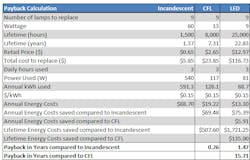I have three large ceiling light fixtures in the middle of three rooms in my apartment. They each have three light bulbs in them, and one bulb in each fixture was burnt out (they are currently a mix of mainly incandescent with 1-2 CFLs). So, I decided I was going to finally purchase some LED bulbs.
Having studied the LED and lighting market for two years now, attended multiple lighting trade shows and conferences, and spoken with numerous people in the top lighting companies, I always felt slightly guilty for not ever actually buying LED bulbs myself. I have done more research on LED lighting than your average consumer; I know all about the different types of lighting technologies, how they differ in wattage and lumen output, and CRI and CCT. These things have become nomenclature for me, my new vernacular. I have even been that person standing in the DIY store with a clipboard writing down all the information about the LED bulbs on sale... yet I still had never bought one. I justify it by saying that I've been renting with roommates for the past six years, and have never lived in one place (or city) for longer than two years in that time frame. My options would be to leave the bulbs and lose money, or to pack them up and take them with me and still have to replace any bulbs I took, as per usual renters contracts – it seemed like a hassle either way. So when I moved to a place where I am planning on being for a while, living and paying for my own energy bills by myself, I decided to replace all nine bulbs with LED bulbs.
I knew exactly what I wanted - A15, E27, 3000K, 60W equivalent dimmable LED bulbs. Only problem was, I couldn't find anything meeting those exact specifications. There were some A15, but they were 40W equivalent and below (the majority were 25W equivalent). Or I’d find the sizes and wattages, but they wouldn't be dimmable, or they'd only be 2700K. I nearly bought some appliance bulbs I found that met all the specifications, except they were only 500 lumens, not nearly bright enough. Also, they were around $13 each (which is actually very cheap considering their prices just two years ago), and I wasn't about to spend over $100 on light bulbs that weren’t going to fully light up my room. I couldn't even find CFLs with those exact specifications. I did find some A15, 2700K non dimmable CFLs, at around $2.50 each, but that was the best I could get.
I was genuinely surprised at how difficult it was to get the bulbs I needed. There wasn't even a very good platform for searching for them on the online websites. Granted, they are not the most common shape or color temperature, and CFL and LED have both had trouble with dimming; however, even just finding out if the bulbs I was looking at were the right size and shape proved to be difficult as most of them were not clearly labeled in the product descriptions. It really doesn’t surprise me that the residential market is so slow at adopting LED lighting compared to commercial, industrial, and outdoor. LED A-lamp, reflector, and MR16 bulbs currently have less than 3% installed in residential, compared with nearly 8% in commercial applications. By 2022, that number is forecasted to be 49% for residential and 80% for commercial for those bulb shapes.
So, what did I end up doing? Well, I turned to math and did a simple payback calculation based on the products I was comparing and the $/kWh in my area:
It’s very easy to see that both LED and CFL are far superior compared to Incandescent, but what about CFL compared to LED? Sure, I would eventually get the payback on my LED bulbs (a mere 15 years from now...), but to me, and probably many other consumers out there, that’s just not worth it. Even the year and a half payback seems too long for me; I could move in that time, and LED prices continue to fall year on year. However, a payback in 3 months, now that is definitely worth it.
So what started out as a genuine attempt to support the industry I work in, save some energy, and be green, turned into getting confused by the different types of bulbs available (I should tell you that, before I got into this business, I would have had no idea that I needed an A15 bulb, so I can only imagine what a person outside of this business thinks when they’re looking online for bulbs). I ended up getting...CFLs.
Maybe next time…







